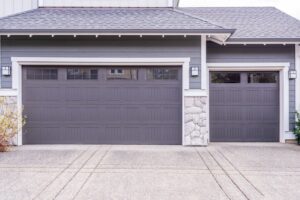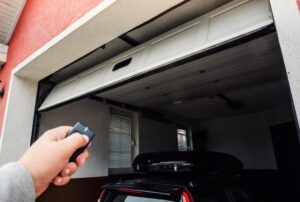Without a doubt, the garage is the largest part of most residential homes and also the most prominent feature on the frontal facade. As such, garage doors provide the largest opening into a house, as well as the most vulnerable. In its most conventional design, the garage door is weak in that air can pass through easily and bring the garage space down to outdoor temperatures. During winter months, this can be problematic.
In order to understand the importance of garage door insulation, one must first understand how the barrier between outdoor and indoor temperatures work with regards to the garage itself:
- R–Value. This determines the insulating strength of a garage door. The higher the R–value rating, the greater the insulating properties.
- Thermal boundary. The line between outside ambient air and inside conditioned air. In most homes, the thermal boundary is usually not the garage door, but the wall between the garage and living area.
Basically, the garage rarely provides much in terms of thermal boundary, unless insulation is added to the door itself.
Insulated Garage Doors vs. Non Insulated
From the outside, you can’t really tell the difference between an insulated and non–insulated garage door. Therefore, there’s nothing to be gained or lost in the aesthetic sense if you have insulation added to your garage door. On the plus side, there are plenty of advantages to an insulated garage door. However, insulation must be applied properly for a garage door to handle its daily functions without getting weighted down.
So what are the differences between insulated garage doors vs. non–insulated doors? Primarily, things break down to the warmth and noise factors.
Insulated. An insulated garage door keeps the garage space warmer, and this in turn keeps houses warmer. The reason for this difference is the improved insulation of the garage itself, which otherwise holds very little insulation. Insulated garage doors are generally quieter due to the polyurethane foam board, which acts as a noise absorbent.
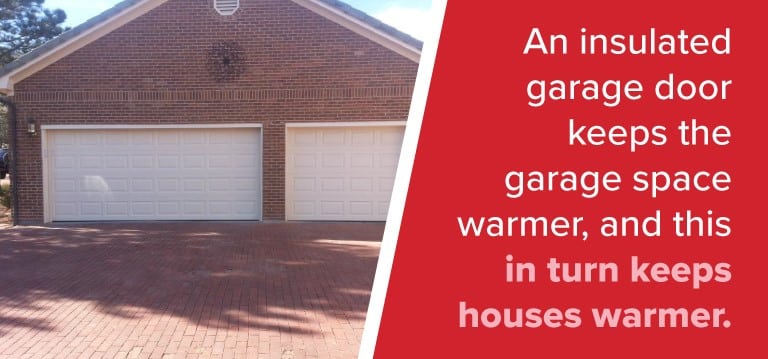
Non insulated. Garage doors with no insulation will generally expose garage spaces to the temperatures outside. Most non–insulated garage doors are also noisier because they usually consist of single–layer metal panels that rattle and creak with each up–and–down movement. As such, non–insulated garage doors are sometimes referred to as “beer cans.”
For homes in hot climates where coldness is a lesser factor, garage–door insulation can still have its benefits. If you live in an area where rodent infestations are a known threat, insulation can help keep those critters out of your garage and, by extension, out of your house. With an insulated door, there’s fewer opportunities for rats or mice to slip inside when it’s dark or raining.
Do Insulated Garage Doors Make a Difference?
Depending on the size of your garage and its placement in the overall layout of your property, garage door insulation could be a minor or major boon to the comfort of your household. For example, if your garage is adjacent to your living room, an insulated garage door could keep everyone warmer while sitting in front of the television or fireplace. If your garage is detached from your house, insulation might not even be necessary unless you live in an area that gets extremely cold during winter.
Is it worth it? When it comes to insulating a garage door, the short and long–term effects will largely rely on the method at hand. If a garage door is insulated in the same manner as a wall or ceiling, the insulation will keep the garage warmer for a few months or more, until the foam board starts to flake due to the constant movement and folding — actions which foam boards aren’t made to endure on an ongoing basis. Therefore, the more appropriate way to insulate a garage door is with the addition of a weather seal.
Is it effective? Insulation is effective at keeping garage spaces warmer than the ambient temperatures outside. When it comes to the overall temperature of household living areas, this can make a huge difference, because the thermal boundary is enhanced. As such, households conserve more insulation, because there’s less air leaking through this large but generally less insulated part of the house. Instead of the garage door making a cold space even colder each time the door is risen, a lukewarm space is momentarily cooled, but soon warms back up once the door comes down.
How effective is it? Admittedly, the difference in temperature between an insulated and non–insulated garage space is slight, but the impact it can have on the insulation of household living spaces is significant. For example, if the weather outside on a winter day is 20 degrees, a garage with a non–insulated door might only be 10 degrees warmer, whereas a garage with an insulated door could be at least 20 degrees warmer. The jump from 20 to 40+ degrees between the driveway and garage space is the difference between below–freezing and above–freezing temperature levels. On days like these when you need to keep your house warm, garage–door insulation can help reduce energy consumption and lower your heating costs.

What does it protect? Depending on how you might use your garage, an insulated garage door could make the space itself more suitable for storing items and parking vehicles. Your car, for example, could fare much better overnight and on weekends during cold and snowy months if parked in an insulated garage. In fact, it could be one of the foremost necessities of keeping your vehicle in operable condition during winter, since some cars fail to start after several hours in freezing temperatures.
An insulated door can also make your garage safer for personal belonging such as clothes, books and photo albums. This is due to the reduced possibility of mold formations on anything stored within a garage. Since there’s less cold air seeping into the garage area, moldy residues are less likely to form along inner walls and leave odors on papers and fabrics. Simply put, an insulated door can make your garage into a much more hospitable storage space.
Benefits of Insulated Garage Doors
Are you wondering “Do I really need an insulated garage door?”, the benefits of insulation generally outweigh the drawbacks. However, since conventional forms of insulation are an added element, problems can arise over months of daily usage. Simply put, insulation in foam form can be an awkward addition to a garage door. Moreover, insulation can be difficult to apply to a garage door, and shouldn’t be attempted by anyone who lacks experience in such applications. So what exactly are the pros and cons of insulating garage doors?
Pros. The benefits of insulated garage doors include added warmth to households due to improved thermal boundaries. When your garage door is insulated, the door itself is rendered more air–tight. Therefore, air has less ability to slip between the panels and make your garage space cold on winter days.
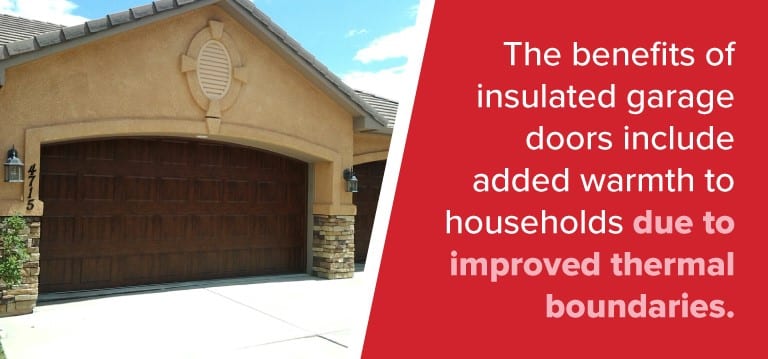
With enhanced warmth to the garage, the adjacent living areas have a stronger buffer zone from the outside cold. When temperatures dip to freezing levels, an insulated garage door can keep your house warmer around the clock. That way, you can ease up on your heating system and lower your energy bills, which can lead to huge savings over the course of a cold season. The pros of garage door insulation are as follows:
- Increased warmth within a garage space.
- Strengthened thermal boundary, which improves the overall insulation throughout a house.
- Provides more suitable parking temperatures for your vehicle/s during winter months.
- Enhanced sound barrier — if you work with tools in your garage, an insulated door can absorb noise and shield neighbors from disruption.
- Decreased track noise as the door is raised and lowered.
- More hospitable storage for old belongings.
- Keeps rodents from slipping through the garage door and nesting inside.
Cons. When a garage door is insulated the old–fashioned way — i.e. with insulation foam — problems can emerge as time goes by because the folding panels of a garage door are not the same thing as a flat wall. In a wall or ceiling, the foam isn’t subjected to constant folding and unfolding. On a garage door, insulation material is folded and squeezed each time the door panels make the 90 degree turn upward and back down. Furthermore, insulation material can make a garage door heavier, which adds to the wear and tear factor. Basically, an insulated garage door could have the following cons:
- Can flake over time due to constant folding as the garage door is raised and lowered.
- Could need semi–regular replacement due to flaking and unraveling.
- Adds weight to a garage door, which can weaken springs and eventually cause a raised door to dip.
Of course, you can have the pros without the cons by avoiding the standard form of insulation and instead having a weather seal installed on your garage door. Such an installation is best handled by a pro, and it can be done during any round of professional maintenance work on the door, which in any case should be performed annually. However, you can always add polyurethane insulation foam to the walls and ceiling of your garage for an even stronger thermal boundary.
How Strong is Garage Door Insulation?
The strength of the insulation on a garage door is all determined by the R–value. If the value is high, the door has a strong insulation quality. This can be an incredible asset for your home, depending on where you live. For example, if you live in a cold state like Colorado, the insulation on your garage door could be the difference between running your heater almost 24/7 and going easy on the HVAC system. By contrast, a low R–value would offer less in terms of air protection, but could still keep your garage area free of moisture and rodents.
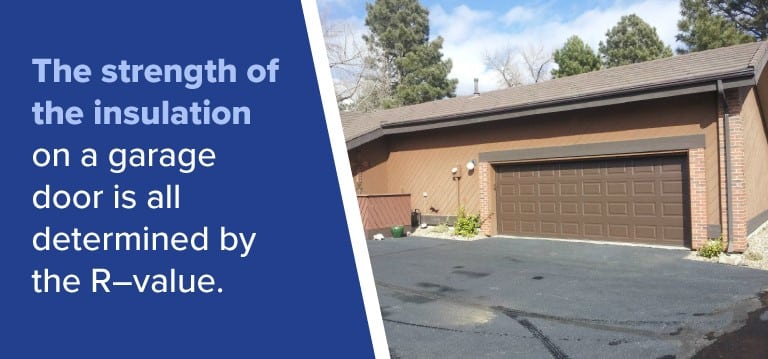
As with any type of insulation, garage door insulation should be inspected on a periodic basis for signs of damage. If the insulation shows signs of tears or flakiness, it’s time to have it replaced with new layers. Alternately, if the insulation has been damaged by moisture, musty smells and molds can easily take root. Then again, an even better way to insulate your garage space is to have weather seal added to the door itself and have foam placed within the walls and ceiling of the garage.
Should You Install Garage Door Insulation Yourself or Hire a Pro?
As with most types of home improvement, the installation of garage door insulation can be a difficult thing to master. For starters, you could have trouble with measurements and the application that could ultimately render the insulation flimsy at best and flaky at worst. Second of all, the insulation could put a strain on the door that could wear down the functions and even render the door dangerous to family, pets and vehicles. Furthermore, the mistakes of a poorly insulated garage door could be costly, because all the hours, money and labor poured into a faulty application could ultimately prove to be for nothing in less than a year’s time. Basically, you run the following risks by taking the job into your own hands with no prior, proven experience:
- Insulation gets poorly aligned to the panels of the garage door.
- Insulation rapidly unravels from the daily movements of the door.
- Insulation weighs upon the garage door, wears down the mechanisms and renders the door dangerous.
- Costs mount as the whole application requires a redo after just a short period of time.
Simply put, there are numerous things that can go wrong with an insulation done poorly, which could ultimately render the insulation worthless and even impact the door’s performance. Therefore, insulation shouldn’t be attempted by those with no experience.
If you want to have insulation added to your garage door, the best thing to do is hire a professional. When you hire a team with experience at handling garage doors, insulation is applied with accuracy and proper measurements that won’t unravel or wear down the door. Best of all, professional installers will usually present alternate methods for keeping the door insulated, such as weather seal, that are much preferable over traditional forms of insulation.
Contact the Experts at American Overhead Door
In Colorado, homes get cold during wintertime. With so much chill sweeping through neighborhoods between the months of November through February, it’s essential that households have proper insulation. On homes with attached garages — i.e. the majority of homes — insulation is needed within the garage to improve the thermal boundaries of the house itself. Otherwise, the outside air that can easily seep into the garage can dilute the insulation and heating in living rooms and bedrooms.
The team here at American Overhead Door have performed maintenance, repairs and improvements on garage doors in Colorado homes for more than 30 years. Whether you want to have your garage door insulated, enhanced with windows or radically redesigned with new material, we offer a variety of garage door services. To see more of what we can do for your garage door or to request a quote, click on over to our garage door service page today.


